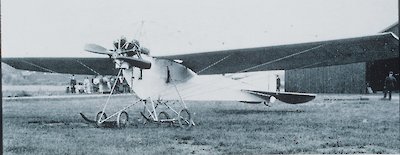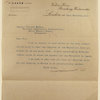Mawson’s aerial plans
In their own words
I am beginning to fear people have had too much Antarctica and need something novel to stir them up again. Your aeroplane may do the trick.
— Letter from Professor Edgeworth David’s wife to Mawson, 13 August 1911.
The idea
When Mawson made the decision to buy an aeroplane for his expedition, the science of flight was still in its infancy. This presented opportunities both practical (reconnaissance in advance of sledging journeys, for instance) and publicity-related (the aircraft could achieve the first flight on the last continent, and could generate publicity).
Mawson decided on the Vickers No. 1 — the first aircraft produced by the newly-formed aviation department of the marine engineering firm Vickers Ltd. The design was licensed from France — the designer was Robert Esnault-Pelterie — and the fuselage was built in France and shipped to England, where its English-built wings were fitted by Vickers.
Bought early in 1911 for £955 4s 8d, the monoplane had a wingspan of 47 feet, length of 36 feet and a cruising speed of 48 knots. It was driven by a 60 horsepower, five-cylinder, air-cooled, semi-radial ‘R.E.P.’ engine. Vickers Limited were later to let payment of the account to lapse because of Mawson’s dire financial position after the return of the AAE.
In 1911 (only eight years after the Wright brothers’ first powered flight), aircraft were a novelty everywhere. Mawson hoped to use it to raise funds through a series of promotional flights around Australia, believing that this could add thousands of pounds to AAE coffers.
The reality
The new aircraft was tested at Vickers’ new Dartford airfield and at Brooklands, Surrey, before being crated and shipped to Australia aboard the steamship Macedonia, accompanied by the Antarctic veteran Frank Wild. Its pilot (Lieutenant Hugh Watkins, an experienced aviator and balloonist) and mechanic (Frank Bickerton) travelled separately aboard SS China.
After take-off from Adelaide’s Cheltenham Racecourse on 4 October, a wing was damaged on landing and repaired by Bickerton. Early the next morning Wild and Watkins decided on one last test flight before beginning fund-raising joyrides.
And then calamity struck. Wild was in the front (passenger) seat when Watkins experienced difficulties soon after takeoff. At 500 feet the Vickers began to side-slip, losing altitude rapidly. Watkins seemed to have things under control, but around 150 feet the aircraft struck turbulence, dropped suddenly and hit the ground, damaging its wings beyond repair.
The accident brought a sudden end to Mawson’s Antarctic flying ambitions, but he could consider himself lucky. In the benign conditions of suburban Adelaide Watkins found the aircraft difficult to handle; he would have found it next to impossible in windswept coastal Antarctica. Neither he nor Wild had been seriously injured, and with the South Australian governor due to be the first passenger, the affair could have ended in disaster. Accidents were common in these early years, with death the frequent outcome.
There had always been the option of using the wingless fuselage as a sledge-hauling machine — an ‘air tractor’. Bickerton would have the task of converting it, but other pressures meant the conversion work would have to be done in Antarctica.


